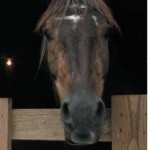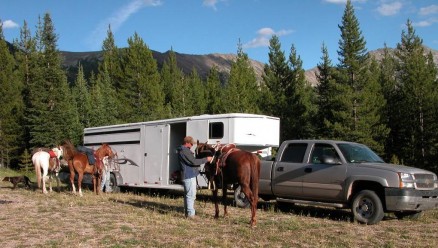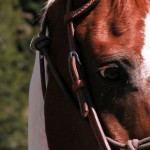Cribbing: Dangers & Prevention
 Nothing is more disconcerting to horse owners than a horse behavior that is both repetitive and harmful. A stall vice is one such behavior; it is a repetitive bad habit a horse can acquire for a variety of reasons. Stall vices can affect your horse’s dependability and/or health, and once a vice is set, it is a very difficult habit to break. Boredom is by far the most common cause of vices, and the most common vice is cribbing.
Nothing is more disconcerting to horse owners than a horse behavior that is both repetitive and harmful. A stall vice is one such behavior; it is a repetitive bad habit a horse can acquire for a variety of reasons. Stall vices can affect your horse’s dependability and/or health, and once a vice is set, it is a very difficult habit to break. Boredom is by far the most common cause of vices, and the most common vice is cribbing.
Cribbing may arise for many reasons:
•Boredom
•Stress
•Nervousness
•Curiosity
•Excessive energy
•Nutritional deficiencies
What is cribbing?
Cribbing occurs when the horse grabs on to something solid and wooden (like a fence post or barn door), sets his incisors into it, arches his neck, and pulls backwards, sucking air through his teeth into his stomach. This creates a pleasurable “head rush” for the horse that can become addictive. A cribbing horse can experience a variety of problems resulting from the vice, ranging from digestive conditions to severe wear of the upper incisor teeth. Cribbing can also cause malocclusions, an undesirable positioning of the upper and lower teeth when the jaw is closed.
A horse can become so addicted to this behavior that it would rather perform the cribbing action than eat. Many severe cribbers lose weight, which can further affect health and/or performance.
Interestingly, horses that are stalled together may tend to exhibit many of the same vices, including cribbing. This is believed to be caused by exposure to the same stressors in the environment, rather than being a learned behavior.
It can be extremely difficult to stop this behavior once it is established, and although there are cures, they can be expensive, such as covering all wood surfaces with rounded metal edges. Other methods for halting cribbing activity include subjecting your horse to expensive surgery or harsh mechanical cribbing collars or straps. In short, it is much easier to prevent the behavior than to correct it after it is set. “Cures” such as cribbing straps, shock collars, or surgery are considered unkind and do not address the underlying factors that cause the behavior.
Prevention
The best way to prevent cribbing is to avoid confining your horses for long periods of time. Turn out your horses more often to give them more freedom and opportunities to burn off excess energy. Do whatever you can to optimize your pasture land for your horse. Another way to tackle your horse’s excess energy is through a feed change. Many owners opt to feed more roughage instead of grain; their horse still gets good vitamins and minerals, but not the excess carbohydrate energy to burn (some studies have shown that a horse fed a high-grain diet, especially a premium grain, has more energy to burn).
Relieve Stress
Whenever possible, reduce stress by allowing your horse (a social animal) interaction with other horses in the stable. Owners report that even having a goat, or a rooster, for a horse to interact with, helps provide a social outlet that can relieve the stress of confinement.
Regular exercise will also help reduce stress and provide sensory stimulation. Ride him in different environments, so his brain can be even more stimulated. Enroll your horse in a training session. Provide stimulation through toys, like Pony Pops or a Jolly Ball to play with and combat boredom. Play the radio when your horse is stalled. Other owners rely on massage therapy to reduce their horse’s stress.
Deter cribbing through avoidance
Make the surfaces your horse cribs upon less desirable. Coat the surface with cayenne pepper, or an anti-chew spray. These products provide a very strong taste deterrent that may stop your horse from grabbing and cribbing objects such as stall doors. Some owners go through the expense of installing rounded metal edges on cribbing surfaces to deter cribbing.
Cribbing is an unfortunate, and usually preventable, habit. Instead of scrambling for a cure after it is long established, be proactive in prevention. Give your horses plenty of exercise outside the stall in good pasture land, plenty of environmental stimulation, socialization with other horses or animals, a healthy diet void of nutritional gaps, and your personal affection and attention.
Drs. Foster & Smith Educational Staff
Horse Training Video: The Horse’s Nature
Does your horse have trailer issues?
 It shouldn’t be a surprise that horse trailering often comes with problems. After all, horses are prey animals. That means a horse is always on alert for the newest threat and they always want to have multiple escape routes open to them. That’s why horse prefers wide open spaces-they can scan the horizon for threats while plotting their escape should one really come along.
It shouldn’t be a surprise that horse trailering often comes with problems. After all, horses are prey animals. That means a horse is always on alert for the newest threat and they always want to have multiple escape routes open to them. That’s why horse prefers wide open spaces-they can scan the horizon for threats while plotting their escape should one really come along.
With that kind of outlook, imagine how getting in a horse trailer looks. You’re asking an animal that likes to have escape routes available to get into a small, confined space with only one way in or out. And you’re asking an animal that likes to scan wide open areas for threats to get in a confined space that could contain a threat of its own, or at the very least, block the view of what else might be going on.
So we can recognize that problems with horse trailering are actually completely natural, but how do we deal with them? The key is to approach this problem the same way you would with any other horse problem. First and foremost is leadership. You need to be a leader in the mind of your horse otherwise he’s not going to be willing to follow you into difficult or stressful situations.
It should already be part of your normal routine-but specifically when you’re planning on trying to get your horse in the trailer, take him nearby and run him through a groundwork routine before asking him to get in the trailer. Include some backing up, flexing, dropping the head, basic yields and above all some lunging. Gradually get the horse closer to the trailer.
When you’re near the trailer, it’s time to implement another strategy-getting the horse to see the trailer as a place of rest and comfort. Implement a new rule that’s going to be enforced during trailer training sessions. If the horse is right next to the trailer, he gets to rest. Away from the trailer, it’s time for some work (lunging will do). The first time you get near the trailer, let the horse walk up and smell it. It’s OK at that point if he doesn’t step in. Let him smell it and look it over, then walk him away for some more lunging for 2-3 minutes. Then approach again.
This time ask him to put a front foot in. Encourage this by putting some pressure, using a crop or carrot stick. Use a “driving game” approach and tap on his back to encourage him to go forward. When he does, take the pressure off. At first aim for small goals, asking the horse to put one foot at a time. When a goal is met, back the horse out of the trailer and start the process all over again. Go back to lunging for a couple of minutes, then walk him back up to the trailer, allow him to rest, and ask him to go in once again.
This is a process of approach and retreat. Right before the horse is going to come unglued, back him out of the trailer. This teaches the horse to stay calm. By building his confidence in small increments and avoiding the situation where he lets his fear the best of him, we slowly get him used to the idea that the trailer is safe and he will just walk right in.
Notice we haven’t talked about using any treats or placing grain the trailer to coax him in. This approach is based on being a leader for your horse, not trying to bribe him. Using this method will produce longer lasting results.
David McMahon is a freelance author and horse owner. He invites you to visit http://horse-training-tips.com where you can learn more about horse trailering.
Understand Your Horse’s Brain on Trail Rides
 Before you can resolve certain unwanted trail behaviors, you need to see them from your horse’s point of view. Here’s a view of trail riding as your horse may see it.
Before you can resolve certain unwanted trail behaviors, you need to see them from your horse’s point of view. Here’s a view of trail riding as your horse may see it.
Why do some otherwise-calm horses turn into impossible idiots on trail rides with other horses?
Why do they jig, throw their heads, prance in place, even rear or buck, if not allowed right up at the front of the group?
Why do some horses get so hooked on being with a buddy they fall apart at the first hint of separation?
Why the spooking at seemingly ordinary sights, such as rocks or stumps?
What’s with the big fights over water crossings, bridges, and other obstacles with horses that are stars on arena trail courses?
Why do some horses get especially anxious when trail-ridden through dense brush or stands of trees?
And among the most perplexing questions of all: Why do well-broke, seasoned show horses turn out to be some of the worst offenders at any or all of the above?
I didn’t have to invent any of those scenarios. From private rides to saddle-club treks, from pack trips and endurance competitions to casual weekend campouts, from parties of three to parties of 300, I’ve pretty much seen and done it all on the trail-riding front. And that includes coping with my own share of mounts whose initial responses to hitting the trail were educational in their own right.
With that background to draw from, plus some key info about equine psychology, I’m going to help you get “aha!” answers to common trail-behavior puzzles. While insights alone won’t get your horse trained to be a better trail mount, they will help you make better sense of any how-to training plan you decide to follow.
Herd of Prey
Picture this: You’re in the first hour of an organized group ride you’ve looked forward to for ages–and you are not having any fun. Your horse is being a you-know-what, doing everything but bucking in place as he fights to get up with the lead horses.
In your mind: You can’t believe he’s being such a jerk! But at this point, you just hope you survive the ordeal of being on your horrid horse.
In his mind: He’s just trying to survive too, and in the most literal of terms.
What’s up: Horses evolved as herd animals, and that means they’re prey animals, too. From your horse’s point of view, he’s found himself in the middle of a herd on the move through unfamiliar territory. His hard-wired herd instincts have kicked in, and they’re telling him, in no uncertain terms, that his best chances for survival are up near the horses in front. In herd hierarchy, the lead horses aren’t just the experienced leaders. They’re also the least likely to be caught and eaten by a predator.
More horse sense: When your horse is busy obeying his instincts, he can’t really pay attention to obeying you. He’s acting from anxiety, if not out-and-out fear, and that’s got his adrenalin up. The worst thing any rider can do in a situation like this is to come unglued and try to punish the horse into slowing down and minding. All that does is send the horse’s anxiety level up higher, encouraging even more frantic behavior.
To meld minds: Be aware that relaxed and obedient trail behavior, particularly in group settings, doesn’t come naturally to a horse. It requires specific training and accumulated experience, just like any other performance skill set does. One training objective is to establish trust/obedience habits that will help you over-ride those herd instincts once they’ve been activated.
The Buddy Syndrome:
Picture this: You and a barn mate trailer your two horses to a saddle club’s monthly ride. Your horses never act inseparable at home, but now they’re frantic if they’re more than 3 feet apart. Not only that, but yours also acts threateningly toward any other horses that get near his new BFF. He just tried to kick one that got too close to the horse he’s now buddied up with.
In your mind: You have every reason to be shocked, not to mention frustrated and embarrassed, by your horse’s uncharacteristic behavior. He’s like a horse you don’t even recognize!
In his mind: If the first rule of herd survival is to keep from being eaten, the second is to stick with and protect the herd members your horse knows best. He’s thinking, “that other horse from my barn is the only one I know, and I’m not letting him out of my sight. Not lettin’ some other horse come along and run him off, either!”
More horse sense: Horses don’t necessarily have to be full-time best friends to exhibit the buddy syndrome. They can form a compulsive, protective bond in the time it takes to travel to an event in the same trailer, or by spending a night in adjoining corrals or pens before a ride starts. It’s another manifestation of herd instinct.
To meld minds: Think proactively, and think long-term. If you don’t want to deal with a buddied-up horse (and who does?), minimize your contributions to the human behaviors that help reinforce it. For instance, it might seem easiest to give in and let your horse glue himself to his buddy for the duration of your trail ride, but that only serves to confirm unwanted behavior. It might be more convenient for you and a partner to keep your horses penned together on campout rides, but it also feeds that inborn buddy-up need.
Difference Detector
Picture this: You have a horse who’s mastered every scary arena trail obstacle ever devised by mankind. Yet when you ride him out on a trail, it’s a different story. There, he spooks at everything! He’ll negotiate any water obstacle while surrounded by people in a grandstand, but ask him to cross a trickle of a creek out of a trail ride? That’s a guaranteed battle.
In your mind: This horse has got to be one of the dumbest ones who ever lived! He acts like he’s never seen this stuff before.
In his mind: He hasn’t seen anything like this before. To him, the obstacles and circumstances aren’t the least bit related.
What’s up: He’s demonstrating the fact that while horses have a relatively high ability to differentiate, they have a correspondingly low ability to categorize, or put things into related groups. If your horse could talk to you in human language, he might say, “Dude–just because I can fly a plane doesn’t mean I can sail a ship!”
More horse sense: Once again, you can thank evolution for how your horse’s brain might work in a trail ride. In the wild, the better a horse is at detecting differences between the familiar and the unfamiliar, the better his chances of not making a mistake that could cost him his life. Evolution rewards wariness in a prey animal, not risk-taking. You may see an obvious connection between the arena trail obstacles and the ones out in the open, but your horse sees only the differences. As an instinct-programmed prey animal, he acts accordingly.
To meld minds: Don’t make the mistake of believing that your horse’s physical prowess matches up with his abilities upstairs. Just because he can traverse something with his legs doesn’t mean he can do so automatically in his equine brain. That brain needs gradual exposure and habituation–trailing, in other words–to cope with anything that’s different, inside an arena or out.
What Lurks Within
Picture this: You, your significant other, and another couple reserve sports at a forested horse camp for the weekend. You all look forward to riding and enjoying the beautiful, cooled-air trails through the trees. But once you saddle up and get going, one of the four horses has other ideas. He acts like the bogeyman is going to jump out and gobble him up at any moment, especially when he’s asked to bring up the rear.
In your mind: He’s making a big deal out of nothing.
In his mind: He has a perfectly good reason to be channeling the Cowardly Lion from The Wizard of Oz. (“Lions and tigers and bears, oh my!”) The bad guys with claws and fangs could leap from the shadows at any moment.
What’s up: Centuries of domestication haven’t erased the fact that horses evolved as dwellers of vast, open plains. In this kind of country, a horse gets long views of his surroundings and can opt for routes that avoid the kinds of treed or brushy places where predators might hide. Deep woods don’t give him those options, and can trigger prey-animal anxiety.
More horse sense: The instinct to seek open areas and avoid potential close-quarter predator habitat is stronger in some horses than others. Like most aspects of a horse’s life, habituation is key to acceptance of out-of-the-ordinary circumstances.
To meld minds: Give consideration to where a horse might be coming from on this one. If yours has no history of exposure to a forested or otherwise close-quarters setting, it’s a stretch to believe he’ll find it as relaxing and refreshing as you do.
Show Me The Stall
Picture this: You own a show horse that’s an ace at every arena task you’ve ever asked him to do. He’s broke, broke, broke! But as a trail-riding mount, he’s a nightmare. It doesn’t matter whether he’s with a group or out on the trail by himself–all he seems to care about is rushing back to his comfort zone inside some kind of enclosure.
In your mind: You’re doing him a favor by getting him out past arena rails and stall walls.
In his mind: Enclosures aren’t a form of jail to be avoided. They’re what the horse knows and feels comfortable with.
What’s up: As creatures of habit, horses are capable of adapting so well to a regular environment; they can end up embracing one that might seem counterintuitive to you.
More horse sense: Meet your horse halfway on this one. A horse that’s accomplished at arena work has had a lot of gradual practice at accepting and feeling secure within its confines. To counteract that familiarity, he needs similar gradual practice at accepting and dealing with the world outside an arena. You may have been mistaking his degree of arena training for something with universal application. But as he’s proved, it isn’t necessarily so.
Juli S. Thorson This article appeared in the June 2009 issue of Horse & Rider magazine.
